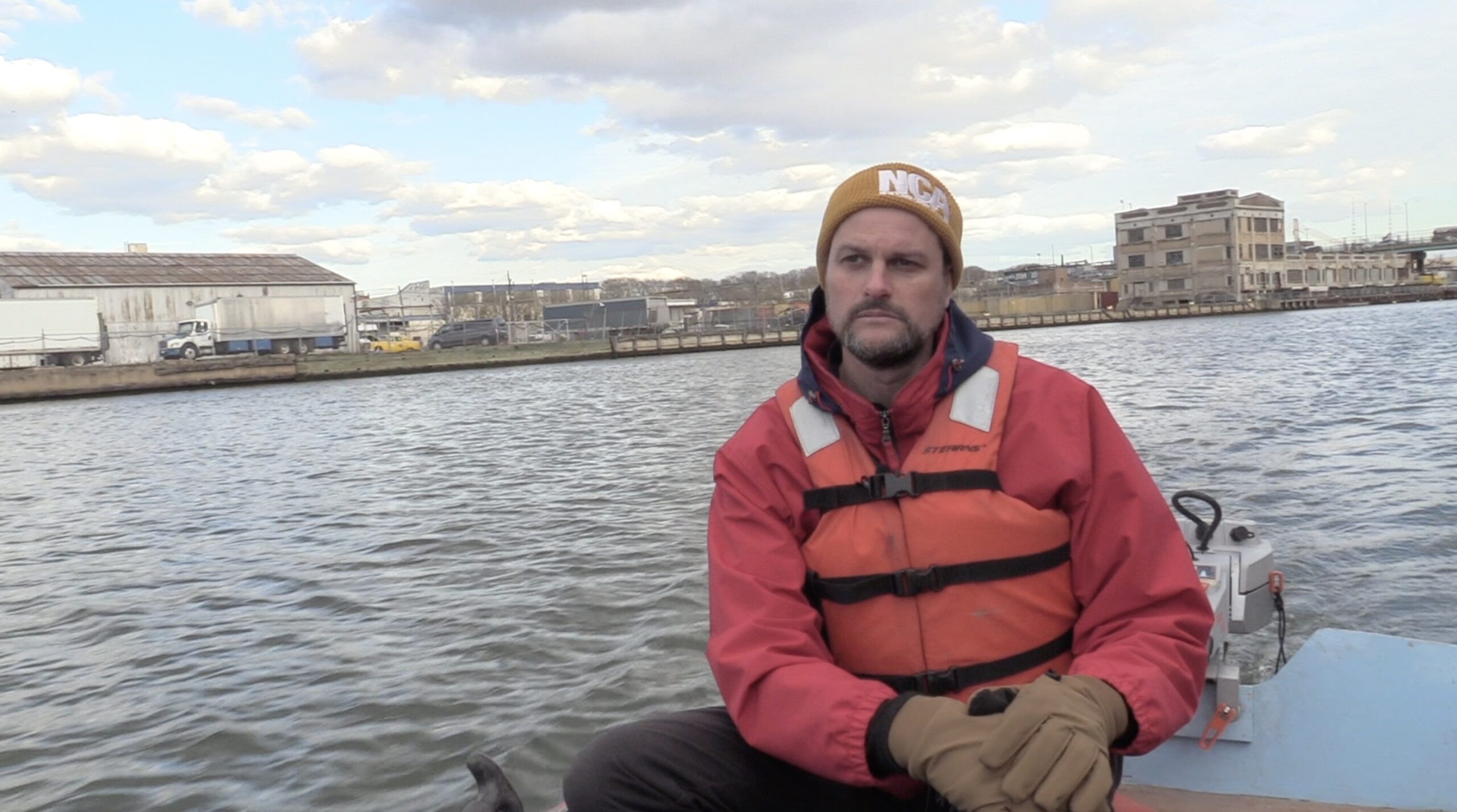Toxic sludge & black mayonnaise: Cleaning up one of New York’s most polluted waterways
How a local alliance is working to restore Newtown Creek
Dawn Attride, Sara Hashemi, Avery Orrall • November 1, 2024

Willis Elkins, executive director of the Newtown Creek Alliance, working to clean the waterway. [Credit: Dawn Attride]
Newtown Creek borders Brooklyn and Queens, and is one of the most polluted ecological sites in the U.S. from the many industries contaminating its waters. The largest pollution incident was the Greenpoint Oil Spill discovered in 1978, where up to 30 million gallons of oil pollutants seeped into the creek. Today, the creek is bordered by factories and waste management sites that add to its poor water quality. The Newtown Creek Alliance, a community-based organization, is working with local researchers to clean these waters using ribbed mussel colonies and kelp lines. In this short video, we talk to those championing this restoration of the creek and explore how these nature-based techniques purify the water.
DAWN ATTRIDE: Newtown Creek is a three and a half mile body of water branching off the East River. It traces the border between Brooklyn and Queens. And it’s one of the most polluted industrial sites in the United States. So polluted, in fact, that the Environmental Protection Agency declared it a Superfund Site in 2010
SARAH DURAND: So all the industrial waste that is accumulated at the bottom of the creek is affectionately referred to as black mayonnaise. And that waste has a lot of petrochemical carcinogens. These carcinogens are so abundant because Newtown Creek was the center of the oil and gas industry for decades.
DAWN ATTRIDE: Even today, the creek is bordered by factories, automobile scrap yards, and waste management sites. But not all hope is lost. Some organizations are actively trying to clean up these waters, such as the Newtown Creek Alliance.
WILLIS ELKINS: Newtown Creek Alliance is a community based organization. We’ve been around since 2002. Our primary objective is to clean up Newtown Creek. We work to reveal, restore and revitalize the waterway.
DAWN ATTRIDE: Cleanup doesn’t just mean getting rid of contaminants and trash — it also means restoring ecological diversity. Restoration efforts include creating fish and shellfish habitats and introducing species such as mussels and oysters. Some native species, like ribbed mussels, can even filter contaminants from the water.
SARAH DURAND: So having these ribbed muscles on hand to filter out the bacteria is wonderful. So they clear the water they remove pathogenic bacteria. And when they begin to settle on each other, and form what we call mussel mounds, they are forming living space for invertebrate life that needs a hard surface. And the cavities of mussel mounds are great hiding places for developing fish, crab, crustaceans, so small swimming invertebrates and vertebrates find refuge here and a place to eat.
DAWN ATTRIDE: These ribbed mussels can be spotted along a nature walk that was constructed to add life back into the area. It’s lined with grasses and trees and is frequented by runners, pedestrians, and geese, such as these, who come to enjoy the benefits of the creek.
SARAH DURAND: But that experience can be broken by the smell of oil, or a Canada geese trying to get its neck out of a plastic bag.There’s this experience of joy and grief as you’re out on the water. But it is a motivation to continue this effort of restoring, healing the waterway.
DAWN ATTRIDE: But it’s not just mussels that help to restore the water, kelp can help by soaking up contaminants like heavy metals while providing habitats to other marine life. Still, animals in the creek are being affected by cancer-causing pollutants such as PAHs found in gasoline, and PCBs found in electrical equipment. If we eat these contaminated animals, we’re also being exposed to these contaminants. The EPA publicly states that humans are at real risk of exposure from Newtown Creek
WILLIS ELKINS: And that contamination is things like pAH is and PCBs and heavy metals that are carcinogenic, that persists for a very long time, and that build up in the tissue efficient crab. So if you’re out eating, you know, say a blue crab in the creek on a regular basis, you’re exposing yourself to those toxins. The water quality in the creek is better than it’s been in in over 100 years. We also have combined sewer overflow, which is a big issue, both here on Newtown Creek as well as around New York Harbor. And so combined sewer overflow happens when it rains, our sewer systems get flooded essentially from all the stormwater entering the same pipes we flush our toilets into. So in the case of Newtown Creek, we currently have about 1.2 billion gallons of untreated sewage during an average year of rain. And it means that most of the creek does not come into compliance with federal Clean Water Act standards. There’s been some big gains in water quality over the past few decades. But there’s actually still a lot of work to be done. It’s important for the responsible parties to clean up Newtown Creek, the ones who caused the contamination. So those are groups like Exxon Mobil, or national grid, whose former predecessor of companies created all the contaminations here. It’s important to hold the city accountable, because their sewer system is creating that pollution. So they need to know that people that are living and working here care about this waterway, and we want to see it cleaned up. And so there’s a huge need for active voices – people that care about the waterway, live near it, work near it, interact with it already, maybe want to interact with it more if it were cleaner. People here have suffered the wildlife has suffered and we need real action.
Music: “Aourourou” by Azalai on Blue Dot Sessions